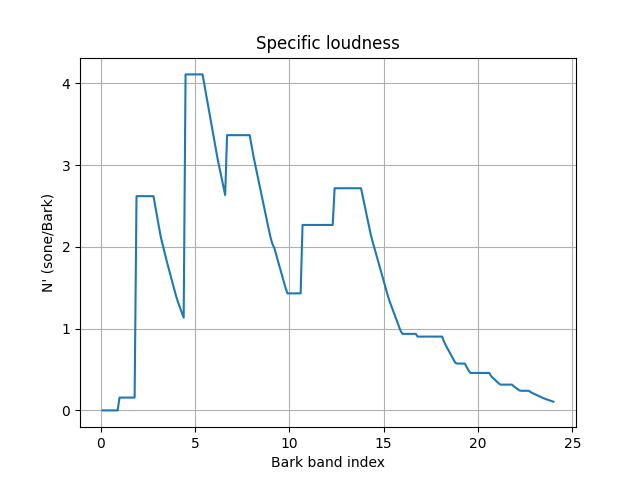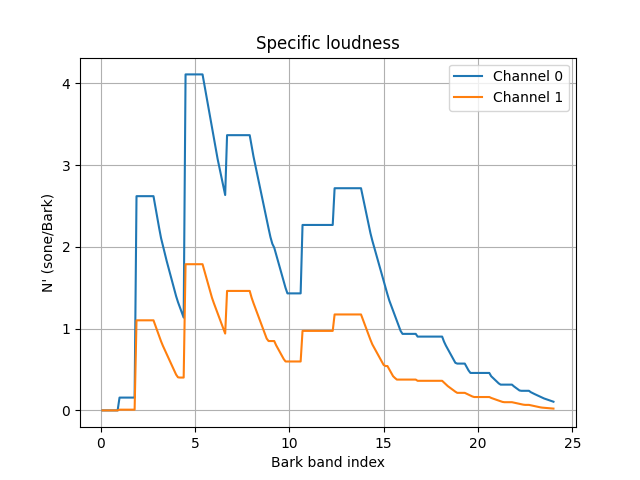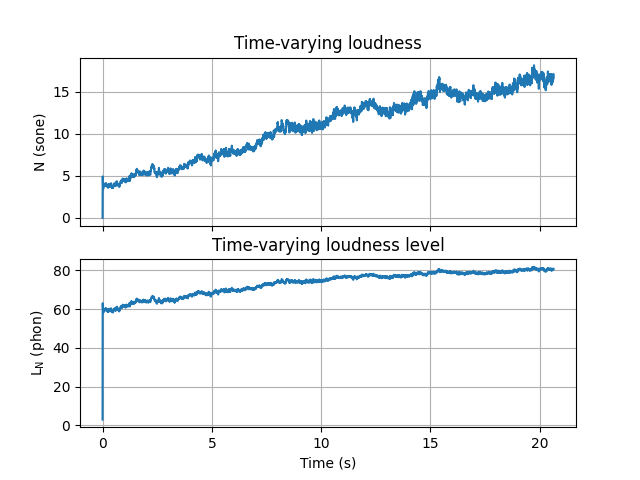Note
Go to the end to download the full example code.
Calculate psychoacoustic indicators#
This example shows how to calculate psychoacoustic indicators. The following indicators are included:
Loudness of stationary sounds according to ISO 532-1.
Loudness of time-varying sounds according to ISO 532-1.
Sharpness according to Zwicker and Fastl, “Psychoacoustics: Facts and models”, 1990.
Roughness according to Daniel and Weber, “Psychoacoustical Roughness: Implementation of an Optimized Model, 1997.
Fluctuation strength according to Sontacchi, “Entwicklung eines Modulkonzeptes für die psychoakustische Geräuschanalyse under MatLab Diplomarbeit”, 1998.
The example shows how to perform these operations:
Set up the analysis.
Calculate indicators on loaded WAV files.
Get calculation outputs.
Plot some corresponding curves.
Set up analysis#
Setting up the analysis consists of loading Ansys libraries, connecting to the DPF server, and retrieving the example files.
# Load Ansys libraries.
import os
import numpy as np
from ansys.sound.core.examples_helpers import (
download_accel_with_rpm_wav,
download_flute_2_wav,
download_flute_wav,
)
from ansys.sound.core.psychoacoustics import (
FluctuationStrength,
LoudnessISO532_1_Stationary,
LoudnessISO532_1_TimeVarying,
Roughness,
Sharpness,
)
from ansys.sound.core.psychoacoustics.roughness import Roughness
from ansys.sound.core.psychoacoustics.sharpness import Sharpness
from ansys.sound.core.server_helpers import connect_to_or_start_server
from ansys.sound.core.signal_utilities import LoadWav
# Connect to a remote server or start a local server.
server = connect_to_or_start_server()
Calculate ISO 532-1 loudness for a stationary sound#
Load a signal from a WAV file using the LoadWav class. It is returned as a DPF
field container. For more information, see fields_container
in the DPF-Core API documentation.
# Load example data from WAV file
path_flute_wav = download_flute_wav()
wav_loader = LoadWav(path_flute_wav)
wav_loader.process()
fc_signal = wav_loader.get_output()
Create a LoudnessISO532_1_Stationary object, set its signal, and compute the loudness.
loudness_stationary = LoudnessISO532_1_Stationary(signal=fc_signal)
loudness_stationary.process()
Get the value in sone or in phon.
loudness_sone = loudness_stationary.get_loudness_sone()
loudness_level_phon = loudness_stationary.get_loudness_level_phon()
file_name = os.path.basename(path_flute_wav)
print(
f"\nThe loudness of sound file {file_name} "
f"is{loudness_sone: .1f} sones "
f"or{loudness_level_phon: .1f} phons."
)
The loudness of sound file flute.wav is 39.6 sones or 93.1 phons.
Plot the specific loudness.
loudness_stationary.plot()

Calculate ISO 532-1 loudness for several signals at once#
Load another WAV file and store it along with the first one.
path_flute2_wav = download_flute_2_wav()
wav_loader = LoadWav(path_flute2_wav)
wav_loader.process()
# Store the second signal as a second field in the DPF fields container.
fc_two_signals = fc_signal
fc_two_signals.add_field({"channel_number": 1}, wav_loader.get_output()[0])
Calculate the loudness for both signals at once.
loudness_stationary = LoudnessISO532_1_Stationary(signal=fc_two_signals)
loudness_stationary.process()
Get the values in sone or in phon.
loudness_sone2 = loudness_stationary.get_loudness_sone(1)
loudness_level_phon2 = loudness_stationary.get_loudness_level_phon(1)
file_name2 = os.path.basename(path_flute2_wav)
print(
f"In comparison, the loudness of sound file {file_name2} "
f"is{loudness_sone2: .1f} sones "
f"or{loudness_level_phon2: .1f} phons."
)
In comparison, the loudness of sound file flute2.wav is 16.2 sones or 80.2 phons.
Plot specific loudness for both signals in a single figure. Note how the first sound has a higher specific loudness than the second.
loudness_stationary.plot()

Calculate ISO 532-1 loudness for a non-stationary sound#
Load a new signal (non-stationary) from a WAV file.
path_accel_wav = download_accel_with_rpm_wav()
wav_loader = LoadWav(path_accel_wav)
wav_loader.process()
f_signal = wav_loader.get_output()[0] # Field 0 only, because the RPM profile is useless here.
Create a LoudnessISO532_1_TimeVarying object, set its signal, and compute the loudness.
loudness_time_varying = LoudnessISO532_1_TimeVarying(signal=f_signal)
loudness_time_varying.process()
Get percentile loudness values.
N5 = loudness_time_varying.get_N5_sone()
N10 = loudness_time_varying.get_N10_sone()
L5 = loudness_time_varying.get_L5_phon()
L10 = loudness_time_varying.get_L10_phon()
file_name3 = os.path.basename(path_accel_wav)
print(
f"\nThe sound file {file_name3} has the following percentile loudness values: \n"
f"- N5 = {np.round(N5, 1)} sones.\n"
f"- N10 = {np.round(N10, 1)} sones.\n"
f"- L5 = {np.round(L5, 1)} phons.\n"
f"- L10 = {np.round(L10, 1)} phons."
)
The sound file accel_with_rpm.wav has the following percentile loudness values:
- N5 = 16.4 sones.
- N10 = 15.6 sones.
- L5 = 80.4 phons.
- L10 = 79.6 phons.
Plot loudness as a function of time.
loudness_time_varying.plot()

Calculate sharpness, roughness, and fluctuation strength#
Calculate sharpness, roughness, and fluctuation strength for the two sounds.
Calculate the sharpness.
sharpness = Sharpness(signal=fc_two_signals)
sharpness.process()
sharpness_values = (sharpness.get_sharpness(0), sharpness.get_sharpness(1))
Calculate the roughness.
roughness = Roughness(signal=fc_two_signals)
roughness.process()
roughness_values = (roughness.get_roughness(0), roughness.get_roughness(1))
Calculate the fluctuation strength.
fluctuation_strength = FluctuationStrength(signal=fc_two_signals)
fluctuation_strength.process()
fluctuation_strength_values = (
fluctuation_strength.get_fluctuation_strength(0),
fluctuation_strength.get_fluctuation_strength(1),
)
Print the results.
print(
f"\nThe sharpness of sound file {file_name} "
f"is{sharpness_values[0]: .2f} acum, "
f"its roughness is{roughness_values[0]: .2f} asper, "
f"and its fluctuation strength is{fluctuation_strength_values[0]: .2f} vacil.\n"
f"For sound file {file_name2}, these indicators' values are, respectively, "
f"{sharpness_values[1]: .2f} acum, "
f"{roughness_values[1]: .2f} asper, "
f"and{fluctuation_strength_values[1]: .2f} vacil.\n"
)
The sharpness of sound file flute.wav is 1.19 acum, its roughness is 0.06 asper, and its fluctuation strength is 0.60 vacil.
For sound file flute2.wav, these indicators' values are, respectively, 1.15 acum, 0.03 asper, and 0.45 vacil.
Total running time of the script: (0 minutes 52.138 seconds)